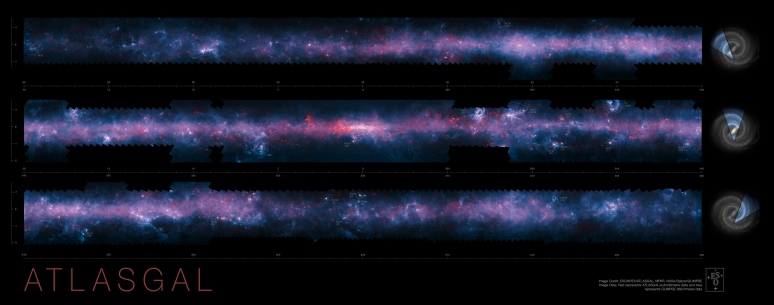APEX Telescope Large Area Survey of the Galaxy (ATLASGAL)

This image of the Milky Way has been released to mark the completion of the APEX Telescope Large Area Survey of the Galaxy (ATLASGAL). The APEX telescope in Chile has mapped the full area of the Galactic Plane visible from the southern hemisphere for the first time at submillimetre wavelengths — between infrared light and radio waves — and in finer detail than recent space-based surveys. The APEX data, at a wavelength of 0.87 millimetres, shows up in red and the background blue image was imaged at shorter infrared wavelengths by the NASA Spitzer Space Telescope as part of the GLIMPSE survey. The fainter extended red structures come from complementary observations made by ESA’s Planck satellite. Many of the most prominent objects are named and the parts of the galaxy that are shown in the three slices are indicated at the right.

This comparison shows the central regions of the Milky Way observed at different wavelengths. The top panel shows compact sources of submillimetre radiation detected by APEX as part of the ATLASGAL survey, combined with complementary data from ESA’s Planck satellite, to capture more extended features. The second panel shows the same region as seen in shorter, infrared, wavelengths by the NASA Spitzer Space Telescope. The third panel shows the same part of sky again at even shorter wavelengths, the near-infrared, as seen by ESO’s VISTA infrared survey telescope at the Paranal Observatory in Chile. Regions appearing as dark dust tendrils here show up brightly in the ATLASGAL view. Finally the bottom picture shows the more familiar view in visible light, where most of the more distant structures are hidden from view. The significance of the colours varies from image to image and they cannot be directly compared.
Some news sources are calling this a ‘map’ which is pretty misleading – there are no ‘places’ we know of exactly and the Milky Way is so mind-bogglingly huge that we could use some new words – but these new views of the Milky Way are amazing and available in very large sizes for you to peruse and try and imagine what kind of wonders lie out there, far beyond our current technology and understanding.
Full information and all images – up to very large scale right here.